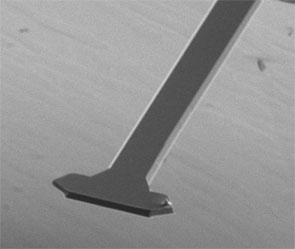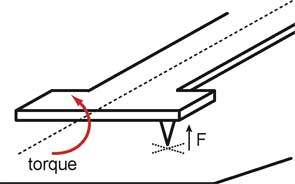| Posted: Aug 07, 2007 | |
Feeling your way through the nanoworld |
|
| (Nanowerk Spotlight) "Children begin to learn by seeing, hearing, tasting and, above all, by touching. In a very similar approach, we are currently learning to orient ourselves in the nanoworld by 'feeling' materials - not with our fingers, but with microscopes that allow us to probe these materials with atomic resolution" (Robert W. Stark, LMU Munich in "Getting a feeling for the nanoworld"). | |
| Researchers' ability to engineer materials and achieve superior electronic, thermal, magnetic, and mechanical properties depends on tools that can identify and characterize material components and their spatial arrangement at the nanoscale. Equally important, understanding structure and function relationships in biological systems also demands tools that can probe structural properties with molecular resolution. | |
| Atomic force microscopes (AFM) are the most widely used tools to image matter at the nanoscale. Due to its mechanical operation, the AFM can in principle also perform nanomechanical measurements. This aspect of the AFM has been explored by researchers over the past two decades. | |
| However, current state-of-the-art techniques are very slow (it takes about one second for the AFM tip to approach, push into and retract from the surface of a material) and they apply rather large forces during the measurement process that damage the tip and the sample. | |
| Researchers at Harvard and Stanford universities have developed a specially designed AFM cantilever tip, the torsional harmonic cantilever (THC), which offers orders of magnitude improvements in temporal resolution, spatial resolution, indentation and mechanical loading compared to conventional tools. With high operating speed, increased force sensitivity and excellent lateral resolution, this tool facilitates practical mapping of nanomechanical properties. | |
| The operation principle of an AFM is based on an atomically sharp tip, placed at the end of a flexible cantilever beam, that is brought into physical contact with the surface of a sample. The cantilever beam deflects in proportion to the force of interaction. Scanning across the surface, the sharp tip follows the bumps and grooves formed by the atoms on the surface. By monitoring the deflections of the flexible cantilever beam one can generate a topography of the surface. This principle has been the basis for one of the most important tools to visualize nanoscale objects where conventional optics cannot resolve them due to the wave nature of light. | |
| During standard AFM operations, the continuous physical contact between the sharp tip and the surface results in damage to both the tip and the sample because of the frictional forces that arise during the scanning process. In order to minimize damage, and also due to some other significant technical advantages, dynamic atomic force microscopy techniques have been developed and became the dominant method of operation. In the dynamic mode the flexible cantilever beam is vibrated on resonance. The sharp tip is periodically approaching and retracting from the surface. At the bottom of its trajectory, the tip makes physical contact intermittently. The amplitude of the vibrations changes due to topographical features. Hence, this mode is sometimes referred to as amplitude modulation or the tapping mode. It is fair to say that any AFM user who has access to this mode prefers to use the dynamic mode over other methods. | |
| Notwithstanding all the advances that have been made in the field of atomic force microscopy, Ozgur Sahin from the Nanomechanical Sensing Group at the Rowland Institute at Harvard tells Nanowerk that a technique that can quantitatively map mechanical properties in detail with nanometer scale resolution has been missing so far. | |
| "Mechanical properties of matter are largely determined by the nature of chemical bonds and their spatial organization in the material" he says. "Furthermore, materials used in everyday life exhibit a huge variation in their mechanical properties. Diamond, for example, is almost a million times stiffer than rubbery materials. The spectrum of mechanical properties of materials spans the range in between these two extremes. Biological systems can be even more compliant. These observations tell that there is a lot of information in mechanical properties of materials." | |
| Sahin is first author of a recent article in Nature Nanotechnology ("An atomic force microscope tip designed to measure time-varying nanomechanical forces") where, together with collaborators from Stanford University (led by Olav Solgaard) and Veeco Instruments, he describes the design of a special cantilever tip that allows the material properties of a surface to be determined and mapped in detail with nanoscale spatial resolution. | |
| "In order to create a high speed and sensitive nanomechanical measurement tool, we have started from the most commonly used AFM technique called the tapping mode" explains Sahin. "The primary advantage of this technique is that it protects the tip and the sample during the imaging process and minimizes the interaction forces. | |
| "For our goal of performing mechanical measurements, tapping mode also provides a unique opportunity because the sharp tip is moving back and forth against the surface and feels the variation of force during the interaction. If one can detect those forces varying with tip sample distance, one can perform a clear and detailed mechanical analysis." | |
| Unfortunately, there are major difficulties in measuring the forces between the tip and the sample. These forces change at a rate much faster than the vibration of the cantilever, therefore the force sensing cantilever cannot respond to them. Indeed, there is a wealth of publications in the literature working on the non-linear dynamics of tapping cantilevers that seek indirect ways to measure these forces. | |
| "In a way, our work stands on the 'shoulders of these giants', because they have reached a very good understanding of the complicated cantilever dynamics in AFMs" says Sahin. "Nevertheless, we have taken a different approach by engineering the force sensing cantilever to measure the interaction forces directly." | |
| Engineering the cantilever | |
| The AFM cantilever has many vibration modes. Each one of these modes can act as an independent force sensor. The rapidly changing forces demand a fast (high resonance frequency) mode to be used. The problem with high resonance frequency modes is that they are stiff and do not bend easily to give a good signal. | |
| "What we have noticed is that torsional vibration modes allow good signal levels and they have high enough resonance frequencies" says Sahin. "Unfortunately, tip sample forces do not excite torsional oscillations because the conventional cantilevers have their tips on the center line. Therefore, we designed cantilevers that have their tips off-centered. When this cantilever hits the surface, tip-sample forces generate a torque that bends the cantilever torsionally. Torsional vibrations can be detected in a commercial AFM system simultaneously with the vertical vibrations." | |
  |
|
| Design of the torsional harmonic cantilever with an off-axis tip. Left: A scanning electron micrograph image of a torsional harmonic cantilever. Right: An illustration of the THC interacting with the surface. The offset position of the tip results in a torque around the axis of the cantilever. (Image and illustration: Ozgur Sahin) | |
| When this cantilever is operated in conventional tapping-mode – touching the surface ever so lightly some 50,000 times per second (50 kHz) – the torsional vibrations can be simultaneously detected and translated into a time-varying tip-sample force waveform which contains detailed information about the mechanical properties of the sample. | |
| "In principle, the speed of these measurements is limited by the oscillation frequency of the cantilever" says Sahin. "At the moment we are not fully benefiting from the speed enhancement, however, it is still more than a factor of thousand times faster than conventional mechanical measurements, yet it is much gentler to the sample. | |
| "Improved speed enables mapping mechanical properties across a surface with nanometer resolution. I believe that in the near future we will see mechanical measurements performed within a microsecond. This will open up a new window to study time dependent phenomena at the nanoscale, such as protein folding and chemical reactions in general." | |
| In their paper, Sahin and his collaborators have demonstrated their technique on a 50 nm thick polymer composite (PMMA – a clear, hard plastic also known under its trade name plexiglas) that has two components with sub-micron features. These components have different thermal characteristics. | |
| Sahin explains that, as you heat up the PMMA, it goes through a glass transition at around 100°C where the hard and brittle polymer becomes rubbery and compliant. "When you heat up a polymer composite, each component has a different glass transition temperature and therefore a bulk measurement will not be able to teach us how individual components behave. The high resolution mechanical measurement technique we presented allowed us to observe the changes in the two components of the polymer independently. This kind of ability is crucial for the development of any material system with multiple components." | |
| An intriguing application with significant potential lies in using mechanical sensing to detect biomolecular reactions. When molecules bind, their mechanical properties change dramatically and in a specific way. Sahin says that a mechanical sensing technique like theirs could lead to label-free, yet specific, detection with single molecule resolution. | |
| Developing this technique further, Sahin sees two distinct paths. "One major direction will be towards biomolecular detection and the other is material analysis" he says, "but there are a number of challenges. AFM in general is difficult to work with in liquids. If this can be resolved, mechanical sensing in liquids will provide exciting opportunities in the study of biological systems and biomolecules." | |
 By
Michael
Berger
– Michael is author of three books by the Royal Society of Chemistry:
Nano-Society: Pushing the Boundaries of Technology,
Nanotechnology: The Future is Tiny, and
Nanoengineering: The Skills and Tools Making Technology Invisible
Copyright ©
Nanowerk LLC
By
Michael
Berger
– Michael is author of three books by the Royal Society of Chemistry:
Nano-Society: Pushing the Boundaries of Technology,
Nanotechnology: The Future is Tiny, and
Nanoengineering: The Skills and Tools Making Technology Invisible
Copyright ©
Nanowerk LLC
|
Become a Spotlight guest author! Join our large and growing group of guest contributors. Have you just published a scientific paper or have other exciting developments to share with the nanotechnology community? Here is how to publish on nanowerk.com.
